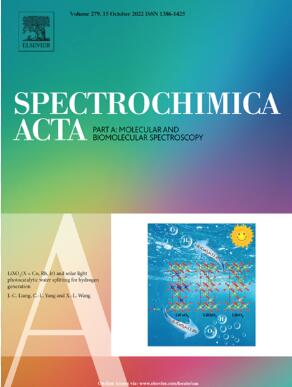h键在玉米醇-香叶醇络合物形成中的作用:对抗真菌活性的影响
IF 4.3
2区 化学
Q1 SPECTROSCOPY
Spectrochimica Acta Part A: Molecular and Biomolecular Spectroscopy
Pub Date : 2025-05-19
DOI:10.1016/j.saa.2025.126431
引用次数: 0
摘要
香叶醇是一种精油,以其抗真菌活性而闻名,然而,它很容易受到环境条件的影响,从而降低其活性。因此,本研究将不同浓度的香叶醇(CG)与玉米蛋白络合,研究其相互作用机制,提高香叶醇的抗真菌活性。光散射技术表明,当CG≤9 mg/mL时,玉米醇-香叶醇(ZG)配合物的水动力直径(DH)从400 nm增加到1200 nm;当CG≤9 mg/mL时,配合物的水动力直径(DH)保持在1100 nm左右;CG≤18mg /mL。然而,在较高的CG (>18 mg/mL)下,DH降低到约400 nm。此外,CD数据表明,随着CG的增加,玉米蛋白的二级结构从α -螺旋向β -片状转变。分子动力学模拟和FTIR分析表明,这些转变是由于玉米蛋白和香叶醇分子之间普遍存在氢键,其中香叶醇分子在玉米蛋白中形成分子内氢键。此外,从荧光光谱研究中获得的热力学参数表明,在香叶醇的存在下,玉米蛋白发生了动态猝灭。ΔH (-157.62 kJ/mol)和ΔS (-480.79 J/mol·K)的负值证实了氢键和范德华相互作用是ZG配合物形成的原因。此外,ZG复合物(CG = 22.5 mg/mL)对白色念珠菌的MIC90略低于纯香叶醇(CG = 25 mg/mL)。ZG与氟康唑配合物的FICI值(0.375)表明其具有协同作用,为开发组合抗真菌治疗提供了线索。本文章由计算机程序翻译,如有差异,请以英文原文为准。
Role of H-bonding in the size-dependent formation of zein-geraniol complexes: Effect on anti-fungal activity
Geraniol is an essential oil known for its anti-fungal activity, however, it is susceptible to environmental conditions which decreases its activity. Therefore, in this study, different concentrations of geraniol (CG) were complexed with zein to study the interaction mechanism and improve the anti-fungal activity of geraniol. The light scattering technique revealed that the hydrodynamic diameter (DH) of the zein–geraniol (ZG) complexes increased from 400 to 1200 nm when CG ≤ 9 mg/mL and remained constant around 1100 nm when 9 < CG ≤ 18 mg/mL. However, at higher CG (>18 mg/mL), DH reduced to about 400 nm. Further, the CD data indicated a transition in the secondary structure of zein from α–helix to β–sheet with the addition of increasing CG. Molecular dynamics simulations and FTIR analysis suggested these transitions were due to the prevalence of H–bond between zein and geraniol molecules, where geraniol molecules acted as bridges to form intramolecular H-bonds in zein. Moreover, thermodynamic parameters obtained from the fluorescence spectroscopy studies indicated dynamic quenching of zein in the presence of geraniol. The negative values of ΔH (–157.62 kJ/mol) and ΔS (–480.79 J/mol⋅K) validated the hypothesis that H-bonds and van der Waals interactions were responsible for the formation of ZG complexes. In addition, the MIC90 of the ZG complexes (CG = 22.5 mg/mL) against Candida albicans was slightly lower than pure geraniol (CG = 25 mg/mL). The FICI value (0.375) of ZG complexes with fluconazole indicated synergistic activity and provided a lead towards the development of combinatorial anti-fungal treatments.
求助全文
通过发布文献求助,成功后即可免费获取论文全文。
去求助
来源期刊
CiteScore
8.40
自引率
11.40%
发文量
1364
审稿时长
40 days
期刊介绍:
Spectrochimica Acta, Part A: Molecular and Biomolecular Spectroscopy (SAA) is an interdisciplinary journal which spans from basic to applied aspects of optical spectroscopy in chemistry, medicine, biology, and materials science.
The journal publishes original scientific papers that feature high-quality spectroscopic data and analysis. From the broad range of optical spectroscopies, the emphasis is on electronic, vibrational or rotational spectra of molecules, rather than on spectroscopy based on magnetic moments.
Criteria for publication in SAA are novelty, uniqueness, and outstanding quality. Routine applications of spectroscopic techniques and computational methods are not appropriate.
Topics of particular interest of Spectrochimica Acta Part A include, but are not limited to:
Spectroscopy and dynamics of bioanalytical, biomedical, environmental, and atmospheric sciences,
Novel experimental techniques or instrumentation for molecular spectroscopy,
Novel theoretical and computational methods,
Novel applications in photochemistry and photobiology,
Novel interpretational approaches as well as advances in data analysis based on electronic or vibrational spectroscopy.

 求助内容:
求助内容: 应助结果提醒方式:
应助结果提醒方式:


